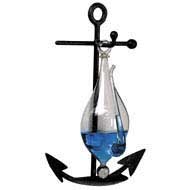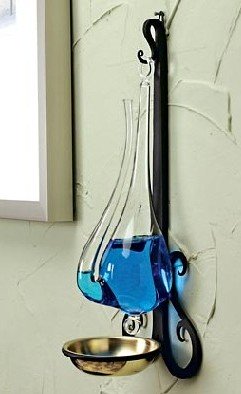|
The Weather Glass - The Farmer's and Sailor's BarometerThe History of the Barometer: Part 2Mercury has always been the liquid of choice in barometers. But, with some ingenuity, water still works. The concept of Air Pressure arrived at almost the same time as the invention of the mercury barometer by Evangelista Torricelli - it was virtually impossible to have one without the other. And Part 1 of The History of the Barometer dealt with the refinement of the mercury barometer and the early use of the barometer and changes in air pressure in weather forecasting. That caught the attention of the scientific fraternity, but more practical and probably less wealthy people had another way of predicting the weather. The Weather Glass Around the time of the barometer's invention, a simple device called a Weather or Storm Glass was developed, although we don't know by whom. The German philosopher Goethe wrote of them around 1700, and they are sometimes referred to as Goethe's barometer. Other names are Water Barometer and Glass Barometer Rising air pressure will push the liquid back down the spout, whereas falling pressure will cause the water to rise in the spout, even to the point where it overflows. The weather glass was a useful predictive tool for farmers and sailors, as a falling level in the spout indicated increasing pressure and generally fine weather, and the opposite suggested approaching rain and storms. The severity of the approaching bad weather was indicated by the rate of change, and by a rise in the level to the point of overflow. 
This was a useful rule of thumb, but it is not known when the connection to changes in air pressure was made. The weather glass was a fine forecasting tool, particularly when used with a weathervane and observation of the skies. Its problem was that it couldn't be reliably calibrated and it was almost impossible to compare one weather glass to another. Other problems exist with using water to measure air pressure - evaporation and freezing. Weather glasses are still made today, mainly for decoration, and make an excellent companion for a home weather station or analog barometer. Amazon In contrast to weather glasses, the advantage of a mercury barometer was that it was actually measuring something, and the measurements were easy to duplicate in other instruments. So there's a good place to step away from the history of the barometer. A lot of development took place over the next 200 years, particularly in surveying, where it was used as an altimeter, and in various navies. But the problem with the difficulty of using and transporting a large instrument with a mercury reservoir was never resolved. The next article reveals where, when and how the next breakthrough in the history of the barometer came. It deals with the Aneroid Barometer, with several other offshoots thrown in. Ever thought of using a leech barometer? You can also find information on Setting and Calibrating Your Barometer, and Home Made Barometers elsewhere in this site, together with reviews of Modern Barometers. This link will take you back to the Top, or, when you're ready, here's how to return to the Home page.
You may be interested to know that you can find out more about weather and home weather stations by receiving our newsletter ,"Watching Weather". It's published more or less weekly, and apart from tips on how to use your weather station and understand what it's telling you about the weather around you, it also covers many other weather related topics. If this sounds interesting, just add your name and email address to the form below. When you join, you'll also receive, totally free, a 20 page guide to setting up and trouble shooting problems in home weather stations. And I promise that you won't get spammed, and that your sign up details will remain totally confidential. Sign up now and receive your first issue almost immediately. Last update 05/28/2011
|





